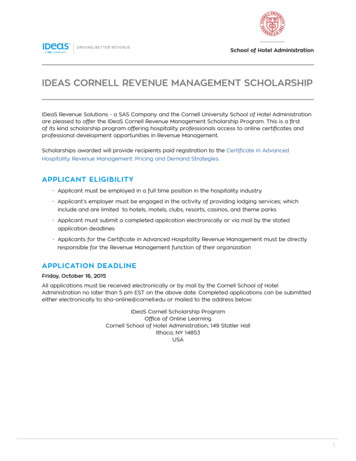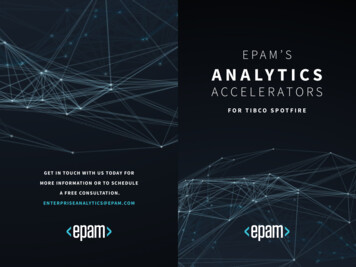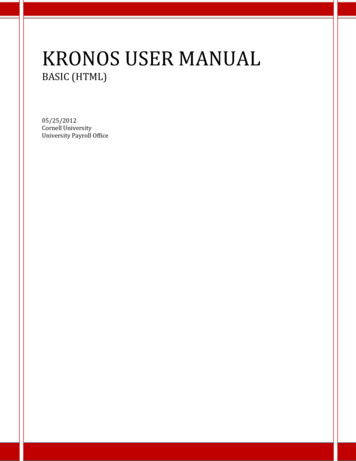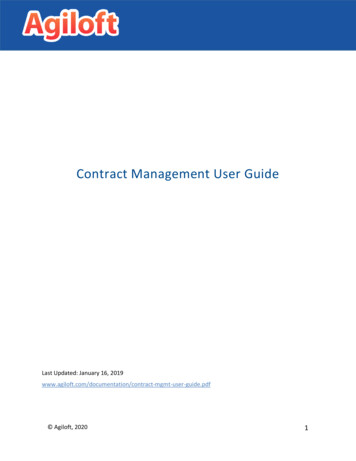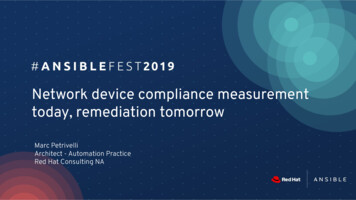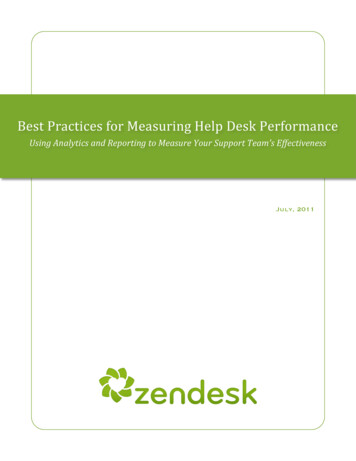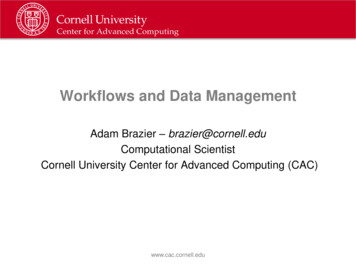
Transcription
Workflows and Data ManagementAdam Brazier – brazier@cornell.eduComputational ScientistCornell University Center for Advanced Computing (CAC)www.cac.cornell.edu
Overview: Summary and Scope Workflows– Automation, our friend and foe– How should we automate a workflow? Data management– From cradle to grave: the lifecycle of data– How should we make a plan? Scope– The (our) university research environment– Process and technology Not providing specific software recommendationswww.cac.cornell.edu
Workflows: what is a workflow? “Workflow” may mean different things to different people. Avoidingdogma, we can consider “workflow” as:1/14/2015www.cac.cornell.edu3
Workflows: what is a workflow? “Workflow” may mean different things to different people. Avoidingdogma, we can consider “workflow” as:– A) What it says on the tin1/14/2015www.cac.cornell.edu4
Workflows: what is a workflow “Workflow” may mean different things to different people. Avoidingdogma, we can consider “workflow” as:– A) What it says on the tin– B) A process which can be illustrated with a flow diagram1/14/2015www.cac.cornell.edu5
Workflows: what is a workflow? “Workflow” may mean different things to different people. Avoidingdogma, we can consider “workflow” as:– A) What it says on the tin– B) A process which can be illustrated with a flow diagram– C) “A series of tasks that produce an outcome” (Microsoft)1/14/2015www.cac.cornell.edu6
Workflows: what is a workflow? “Workflow” may mean different things to different people. Avoidingdogma, we can consider “workflow” as:– A) What it says on the tin– B) A process which can be illustrated with a flow diagram– C) “A series of tasks that produce an outcome” (Microsoft)– D) “A workflow consists of an orchestrated and repeatable pattern ofbusiness activity enabled by the systematic organization of resourcesinto processes that transform materials, provide services, or processinformation” (Wikipedia)1/14/2015www.cac.cornell.edu7
Workflows: what is a workflow? “Workflow” may mean different things to different people. Avoidingdogma, we can consider “workflow” as:– A) What it says on the tin– B) A process which can be illustrated with a flow diagram– C) “A series of tasks that produce an outcome ” (Microsoft)– D) “A workflow consists of an orchestrated and repeatable pattern ofbusiness activity enabled by the systematic organization of resourcesinto processes that transform materials, provide services, or processinformation” (Wikipedia)1/14/2015www.cac.cornell.edu8
Workflows: What do our workflows look like?1/14/2015www.cac.cornell.edu9
Workflows: What do our workflows look like?1/14/2015www.cac.cornell.edu10
Workflows: or some part thereof1/14/2015www.cac.cornell.edu11
Workflows: follow the data!1/14/2015www.cac.cornell.edu12
Workflows: model the processes!1/14/2015www.cac.cornell.edu13
Workflows: why automate? Cheaper, in the long run Speed Reliability, Robustness Repeatability! Faster, better, stronger!One day, you won’t even haveto walk down the stairs yourself1/14/2015www.cac.cornell.edu14
Workflows: what can you lose if you automate? Hands-on involvement, the sense of what’s going on Grad student training ground Development time/cost Team awareness of core processAnticipate the problems1/14/2015www.cac.cornell.edu15
Workflows: the hard part Human intervention most important when things are out of theordinary, which includes failures A requirement of “no failures” is unrealistic in most cases Fault tolerant workflows have mechanisms for surviving failure:– Notifications to humans responsible for workflow Tracking system records errors and their mitigation– Checkpointing In case of interruptions of key services– Error-handling May set aside problematic tasks for later1/14/2015www.cac.cornell.edu16
Workflows: what do we need? Clear requirements.– Avoids a solution in search of a problem High-level, modular/loosely-coupled design– Necessary to assign and estimate effort– Diagram it! Budget– This may really be a time estimateNot the best design approach1/14/2015www.cac.cornell.edu17
Workflows: functional elements Data taking Data transfer Data processing Analysis of results All mediated by software!There’s more than one way topeel a potato1/14/2015www.cac.cornell.edu18
Workflows: available technologies Bulk storage at a variety of performance levels– Robustness also an issue to consider Databases and other organized storage– Allow sophisticated interrogation Networks– Not an issue until it’s an issue If it’s an issue, it’s often a huge issue Software. Sometimes lots of software– Bespoke or third-partyEverything will eventuallyseem old and outdated. Beprepared to change it all Most likely a mix of both1/14/2015www.cac.cornell.edu19
Workflows: storage A key HPC issue is read/write speed.– Basic estimate of simple – 7200 rpm – disk I/O is about 60-70 MB/s– Faster than this is achievable but costs more: Solid State Drives are substantially faster, several 100s of MB/s Many multi-disk enclosures achieve much better performance– Even with fast disk IO, you can’t beat the interconnect/network Stampede and similar HPC clusters have amazingly fast I/O Robustness– Generally achieved with redundancy in arrays of disks (RAID 6 rec.)– Disks for use in arrays are “NAS” or “enterprise” class More expensive than commodity disks– Establish requirements. Monitoring can be a workflow element1/14/2015www.cac.cornell.edu20
Workflows: databases, etc Databases can be queried efficiently, often in Structured QueryLanguage, SQL– Need to be properly-designed Above a certain complexity, may want a DB professional to help– Allows remote access, but be ll.edu21
Workflows: networks Moving data around is easier when “it just works”– See “Data Transfer” talk– External network traffic speed normally limited by network– Internal network traffic speed often limited by disk/array IO Network problems often best referred to professionals– Useful tools to eliminate software/OS as cause: pingLinux ‘ip’ command (cf. ifconfig)netstattraceroutetcpdump– Use -i interface -n -v -vv host hostIP iptables –L –n1/14/2015www.cac.cornell.edu22
Workflows: software Software of key interest in workflows– Control-of-flow (the glue that holds it all together) Often a scripting language: perl, python, bash, etc.– Remote Procedure Call (RPC: allows commands to remote software) “Web services” a common RPC platform– Database access software– Web applications Key functionality:––––Commands activityRoutes dataMonitors activityRecords activity1/14/2015Your authority is delegatedwww.cac.cornell.edu23
Workflows: some software decisions Synchronous/controlled, asynchronous and autonomous– Synchronous calls: send command, await response/completion– Asynchronous calls: send command and then do something else.– Autonomous process: act according to pre-set criteria without explicitcommand– Often processes have autonomous default but can also be commandedto act Checkpointing.– Workflow should recover from loss of state. Deployment of updated software– E.g., pull from repository, rebuild and automated tests1/14/2015www.cac.cornell.edu24
Workflows: example (CCAT Observatory)1/14/2015www.cac.cornell.edu25
Workflows: example (CCAT Observatory)Data source1/14/2015www.cac.cornell.edu26
Workflows: example (CCAT Observatory)Data sourceObservatory Status Database -- theall-knowing brain of the operation.Enables checkpointing.1/14/2015www.cac.cornell.edu27
Workflows: example (CCAT Observatory)Autonomous processes1/14/2015www.cac.cornell.edu28
Workflows: example (CCAT Observatory)Synchronous call1/14/2015www.cac.cornell.edu29
Workflows: example (CCAT Observatory)Synchronous callAsynchronous call1/14/2015www.cac.cornell.edu30
Workflows: example (CCAT Obervatory) Key decisions:– Adopted Python for control software– SQL database– Asynchronous communication via files or OSD One process would write a file and write to OSD File-based communication lower-latency than via OSD File-based communication low-tech but reliable– After detailed study, picked HDF5 file format Fully hierarchical Strong python integration Highly expansible– Enumerated states1/14/2015www.cac.cornell.edu31
Workflows: Key elements of CCAT design Loosely-coupled elements– Fault-tolerant– More pull than push– Asynchronous calls preferred Autonomous operations– Reliable and predictable– Planned move to fully autonomous observatoryCCAT State-controlled– Observatory Status Database (OSD) stores information, serves it out– Autonomous processes act according to OSD information1/14/2015www.cac.cornell.edu32
Workflows: Incorporating HPC (overview) Often you don’t have root on the HPC machine– You may also not be able to get software installed, or policies changed Best use of the HPC resource is asynchronous– Small script to launch processing Should be lightweight– Driven by the availability of data– Submitted to batch queue Don’t hold your breath! (batch queue is asynchronous too)– Record activity of components– Monitor outputs1/14/2015www.cac.cornell.eduIs the data here yet?Is the data here yet?Is the data here yet?Is the data here yet?Is the data here yet?Is the data here yet?Is the data here yet? Imagine a roadtrip with thisautonomous process33
Workflows: Incorporating HPC (methods) Globus can be scripted to get data in and out (cf Data Transfer talk),or scp, etc Depending on policies and permissions, workflow script can be run:––––With screen commandAs cron jobAs linux serviceOn remote host Access HPC resource over ssh with key, run process Execute pre-defined RPC Batch jobs, once submitted, don’t depend on your login sessionbeing live.1/14/2015www.cac.cornell.edu34
Workflows: when to ask for help Domain researchers:– Intimate understanding of the activities– Embedded into the workflow already Typically involved in designing the experiment Often involved in writing the proposal IT professionals– Often more current with available technologies– Typically more practiced– Outsider’s view Provisioning effort and identifying help should be part of planning1/14/2015www.cac.cornell.edu35
Data Management: what is data management? One view (congruent with NSF rage/preservation Another way of looking at it:– Data management enables and underpins the workflow– Your workflow will/should/can achieve NSF/other data 36
Data Management: what is data management? One view (congruent with NSF rage/preservationJust one more thing 1/14/2015www.cac.cornell.edu37
Data Management: what is data management? One view (congruent with NSF rage/preservation CODE IS DATA, TOO!Oh, just one more thing 1/14/2015www.cac.cornell.edu38
Data Management: We need a plan. It’s not justabout proposal hoops. Data Management Plans (DMPs) now required by many RFPs(including all NSF RFPs) Taking planning seriously makes sense:– It allows costing it into a budget– IT OFTEN IS THE WORKFLOW, END-TO-END– A proposal DMP is a higher-level description, but further planningshould take place before implementation begins1/14/2015www.cac.cornell.edu39
Data Management: what is data management? One view (congruent with NSF rage/preservation1/14/2015www.cac.cornell.edu40
Data Management: Description Enumerate your data products!– Include code, documentations, visualizations, online content– Metadata is also data! Decide on formats, including considerations of:– Format longevity Does the format meet likely future demands?– Access to the content elements Is there a common file reader?– Ease of use, including by others Is the format commonly used in the field?1/14/2015www.cac.cornell.edu41
Data Management: DescriptionExamples of data productsRaw data: the original data,as written to diskExamples of data formatsCode: Text (ASCII, Unicode)Graphics: PNG, JPEG, TIFF Intermediary products:includes calibrations,checkpointed files, etcDocuments: PDF, .docx, .xlsx,.txtFinal data products: theresults of processing. May beseveral generations ofproductsRaw Data: binary formats, csv,.txtVideo: .mp4, WMV, .mov1/14/2015www.cac.cornell.edu42
Data Management: what is data management? One view (congruent with NSF rage/preservation1/14/2015www.cac.cornell.edu43
Data Management: Control Control includes things we do to our rocessingVersioningTrackingQuality AssuranceSharing and securityThe rest of us have to use software Many functional requirements arise here1/14/2015www.cac.cornell.edu44
Data Management: control (I/O, transport) I/O– I/O typically handled by operating system and hardware Transport– Physical transport of storage media Wrap it up with padding! Very high effective bandwidth available, but high latency– Internet Ensure you test average speeds and evaluate data transport costs– Very high speeds are expensive– TCP/IP has overhead, window sizes reduce over bad connections– Local network Reliable and typically fast Can often use UDP for higher speeds (also allows broadcast)1/14/2015www.cac.cornell.edu45
Data Management: control (pipelining/processing,tracking) Processing pipelines are workflows themselves– Separate control-of-flow from algorithmic elements– Python, Perl are both commonly used in newer pipelines, callingcompiled code for processing-intensive elements. Quick to develop and debug, where performance isn’t critical. Interface well with compiled code, particularly C/C Tracking should be done with reliable, robust storage– Databases allow powerful queries, preserve data integrity. Flexible May drop incoming data. Sophisticated/complex.– Writing text files simple, well-understood A bit primitive. Querying is effectively “read it all”.1/14/2015www.cac.cornell.edu46
Data Management: control (versioning, QA) Versioning allows tracking of text products (cf Best Practices talk)––––Allow easy reversion of changesCan have multiple people working on same productGit, Mercurial distributed version control systemsSVN, CVS older, centralized version control systems Quality Assurance (cf Best Practices talk)– Testing quality of output is a functional test Can test against set inputs with known output– Can be automated– Should run When new versions of code implemented Other environmental context changed1/14/2015www.cac.cornell.eduThere was only one wayto be sure47
Data Management: control (sharing and security) Enumerate groups and their access– Groups e.g., “project staff”, “research community”, “general public”– Access e.g., “write”, “delete”, “modify”, “read”, “download” Enumerate risks of compromise– Third party access to authentication information, escalation ofauthorization, exploitation of software vulnerabilities, “bad actor”. Evaluate cost of compromise– Permanent loss of data?– Consuming valuable resources (e.g., processing)– Improper release of results or use of resources Can cost prestige, cause embarrassment, endanger ownership, etc1/14/2015www.cac.cornell.edu48
Data Management: what is data management? One view (congruent with NSF rage/preservation1/14/2015www.cac.cornell.edu49
Data Management: policies Policies constrain and guide control, generating non-functionalrequirements/design constraints Key policy issues include:– Who can have our data?– When can they have our data?– Under what conditions? Licensing and attribution requirementsDecisions, decisions– For how long must we keep our data? It is best to decide this early and get agreement from all involved1/14/2015www.cac.cornell.edu50
Data Management: Policies Code-sharing can be done via several licenses:– BSD, Apache, MIT: Permissive. Allow third parties to adapt software,redistribute and not share– GPL and LGPL: “Viral”, must also be applied to redistributed softwarewhich incorporates the (L)GPLed software Licensing, Copyright are different! Check your institutional policies Proprietary periods should typically include releasing results whichsupport publications Retention policies should allow a public release before deletion1/14/2015www.cac.cornell.edu51
Data Management: what is data management? One view (congruent with NSF rage/preservation1/14/2015www.cac.cornell.edu52
Data Management: Storage/Preservation Storage: Persisting the data during the project’s duration Preservation: Persisting the data after the project is completed There can be some hard decisions!– Paid service cost broadly scales with volume. Free services may exist On-campus: CAC’s Archival Storage facility, eCommons (free!), CIT’s EZBackup and department facilities – each serves different needs Github, sourceforge, etc Youtube Journal supplementary data resources Department resources TACC’s Ranch has no purging policy at present, 60PB of tape storage!1/14/2015www.cac.cornell.edu53
Data Management: Storage/Preservation Tape is cheapest, but an automated tape system is expensive. Once a system or component is out of warranty, failure can be costly As disks have become larger, the risk of unrecoverable read errors(UREs) implies RAID 6 instead of RAID 5, and supplementarytechnologies– Much better performance when this is done on the controller, ie, inhardware Investigate appropriate compression– Lossy vs lossless, various compression algorithms depending on dataproperties, e.g, delta compression1/14/2015www.cac.cornell.edu54
Data Management: You are not alone! Research Data Management Service Group (RDMSG,http://data.research.cornell.edu/) provides DMP consulting and otherservices to Cornell researchers For those planning to use CAC services, we will provide help writingData Management Plans and cyberinfrastructure sections ofProposals Many people are addressing similar questions, both inside andoutside Cornell, including many other research institutions.1/14/2015www.cac.cornell.edu55
Workflows and Data Management: Overview Workflow planning and Data Management planning shareconsiderable overlap Evaluate technical options and make decisions (it’s OK to delay finaldecisions until they’re relevant) Identify failure points– Unleash your inner pessimist, then confound them with fault-tolerantdesign1/14/2015www.cac.cornell.edu56
Data Management: Description Examples of data products Raw data: the original data, as written to disk Intermediary products: includes calibrations, checkpointed files, etc Final data products: the results of processing. May be several generations of products 1/14/2015 www.cac.cornell.edu 42 Examples of
